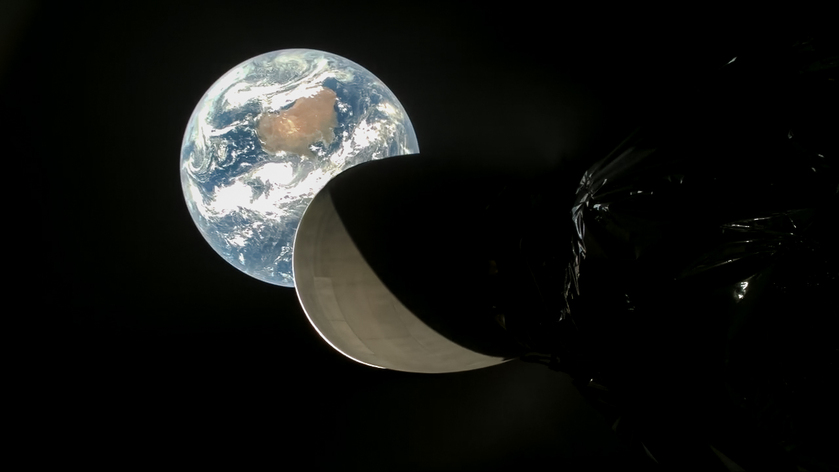A Space Falcon 9 rocket lifted off at 0017 UTC (on Feb. 27) from Launch Complex-39A at NASA’s Kennedy Space Center (KSC) Florida, carrying Athena lunar lander and NASA's ride-along Lunar Trailblazer orbiter. The rocket was also carrying Odin, a spacecraft built by the asteroid-mining company Astroforge, and CHIMERA GEO 1, an orbital transfer vehicle manifested by Epic Aerospace.
As planned, the Falcon 9's upper stage deployed Athena into translunar injection orbit about 43.5 minutes after liftoff and Lunar Trailblazer four minutes later. Meanwhile, the rocket's first-stage booster came back to Earth, landing on SpaceX's A Shortfall of Gravitas droneship 8.5 minutes after liftoff. This was the ninth launch and landing of this particular Falcon 9 booster (B1083).
Built by Houston-based spaceflight company Intuitive Machines, Athena carries 10 NASA science instruments, many of which are designed to hunt for signs of water ice. Lunar Trailblazer will do similar work from its higher perch.
"I'm very excited to see the science that our tech demonstrations deliver as we prepare for humanity's return to the moon and the journey to Mars," Nicky Fox, associate administrator of NASA's Science Mission Directorate, said during a prelaunch briefing.
This is a big priority for NASA, which aims to establish one or more human settlements on the moon via its Artemis program.
Athena’s ambitious mission focuses on the abundance of water ice and other resources near the moon’s south pole, and the prospect for future missions to utilize those resources for sustainable habitability in space — a process known as in-situ resource utilization (ISRU).
The lunar lander is carrying two secondary vehicles: a mini rover named MAPP (Mobile Autonomous Prospecting Platform) that was built by the Colorado company Lunar Outpost and Grace, an Intuitive Machines "hopper" robot that will explore the region around the landing site via a series of leaps.
Athena's IM-2 mission is the second launch to the moon in as many years for Intuitive Machines. IM-2 is part of NASA's Commercial Lunar Payload Services (CLPS) program, which seeks out commercial partnerships to deliver science and technology gear to the moon.
The lander is headed for the moon’s Mons Mouton region, where scientists believe there to be a sufficient amount of water ice deposits for ISRU research. If all goes to plan, the lander will reach lunar orbit four to five days from now, touch down 1.5 to three days after that, and operate on the lunar surface for about 10 Earth days.
Athena's main scientific package is called PRIME-1 (short for Polar Resources Ice Mining Experiment 1). It consists of two separate instruments: the Regolith Ice Drill for Exploring New Terrain (TRIDENT) and the Mass Spectrometer observing lunar operations (MSolo).
This duo will work together to collect and then analyze a sample recovered from underneath the lunar surface. TRIDENT will extract material from up to 1 meter deep, and MSolo will test that sample for compounds like water and carbon dioxide.
The IM-2 hopper — named "Grace," after the pioneering computer scientist and mathematician Grace Hopper — is designed to explore Athena's landing area within a radius of nearly 1 mile (1.6 kilometers).
Grace will bound from one location to another using its thrusters, inertial measurement unit, star tracker, lidar and a situational awareness camera. One of Grace’s main targets will be the permanently shadowed floor of a nearby crater — the type of environment a wheeled rover cannot explore.
The crater floor will be outside the line of sight Grace would ordinarily need to talk with the nearby Athena. The MAPP rover will close this communications gap, for it's equipped with what will be the moon’s first cellular network.
MAPP will deploy onto the lunar surface to test the high-speed, long-range capabilities of the Lunar Surface Communications System (LSCS). LSCS was developed by Nokia Bell Labs and designed with already-available components used in existing 4G/LTE networks.
Athena is also outfitted with a Laser Retro-Reflector Array (LRA) — eight mirrors affixed to the lander, designed to test the reflection of laser light to enable more accurate positioning determination for orbiting and approaching spacecraft. The concept is similar to reflectors on a runway that help guide landing airplanes, and the LRA can operate without the need for power or mechanical control.
Lunar Trailblazer, meanwhile, will make its way to lunar orbit, where it will begin mapping water ice deposits on the surface. The NASA probe's data will be complementary to the close-up information gathered by Athena's instruments, especially PRIME-1, scientists said.
"That will let us contextualize and extend the findings of the PRIME-1 mission to what we might be able to see in other parts of the moon," Lunar Trailblazer Principal Investigator Bethany Ehlmann said.
Once Athena arrives in lunar orbit, it won't be alone. IM-2 and Lunar Trailblazer are the third and fourth missions to the moon so far in 2025. Firefly Aerospace's Ghost Riders in the Sky mission and Japan-based ispace's Resilience lander both launched toward the moon in January, with Firefly's Blue Ghost scheduled to land just a few days before Athena.
That mission is also flying under NASA's CLPS umbrella, and will deliver a whole different suite of NASA science and technology payloads to the lunar surface. Resilience isn't flying any NASA payloads, but the space agency has contracted ispace to collect some lunar regolith (moon dust) for NASA, which will technically take ownership of the sample even though there are currently no plans to return it to Earth.
IM-2 follows Intuitive Machines' historic first mission, IM-1, by just over a year. The IM-1 lander, "Odysseus," launched in February 2024, also on a CLPS flight. Odysseus managed to make it to the surface, pulling off the first-ever soft lunar landing by a private spacecraft. But the probe came in too fast and broke one of its landing legs, which caused it to tip over during the touchdown. As a result, the spacecraft’s high-gain antenna was blocked, preventing the transmission of some of the data that NASA had hoped to collect.















